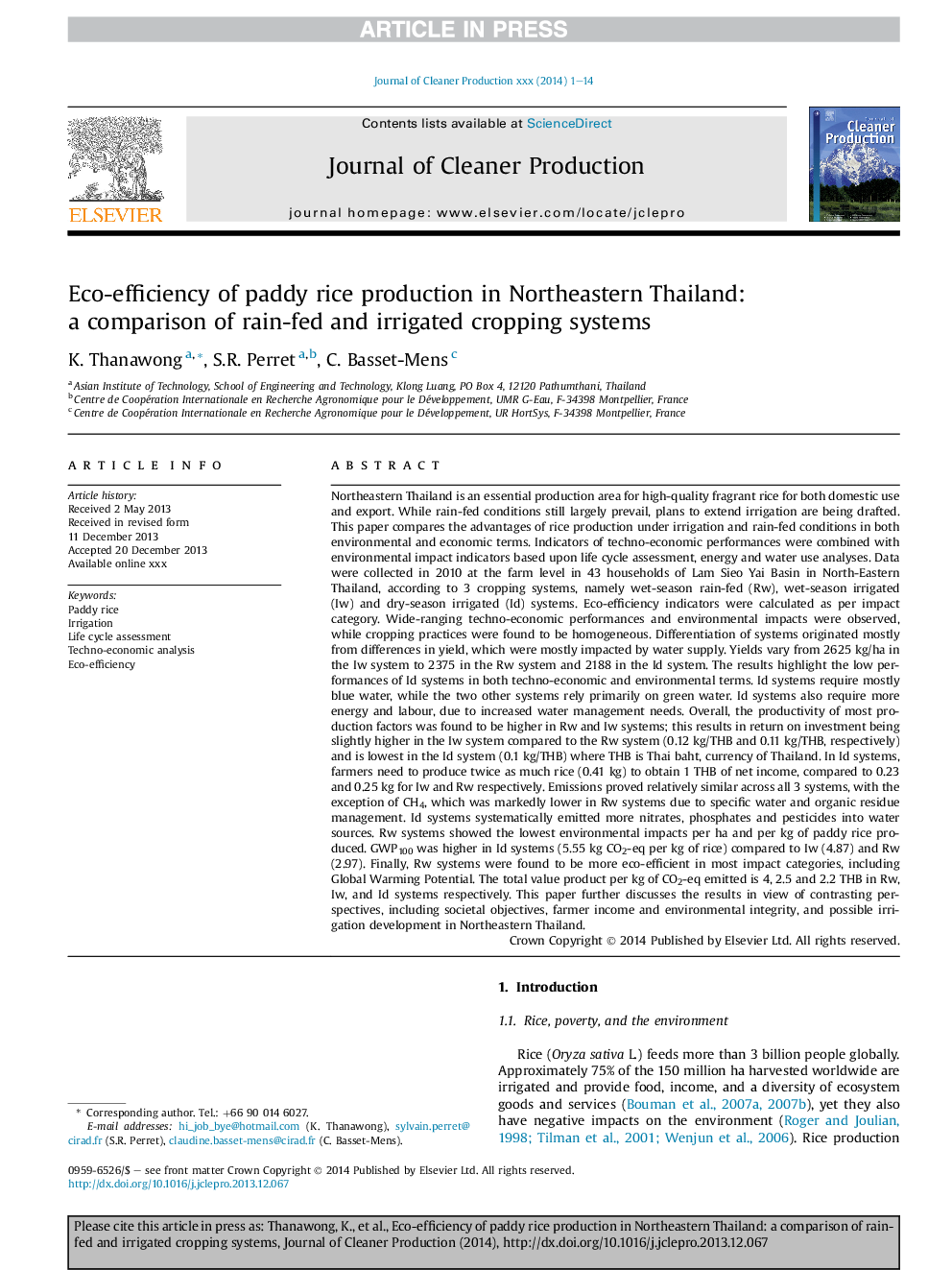| کد مقاله | کد نشریه | سال انتشار | مقاله انگلیسی | نسخه تمام متن |
|---|---|---|---|---|
| 8106373 | 1522173 | 2014 | 14 صفحه PDF | دانلود رایگان |
عنوان انگلیسی مقاله ISI
Eco-efficiency of paddy rice production in Northeastern Thailand: a comparison of rain-fed and irrigated cropping systems
دانلود مقاله + سفارش ترجمه
دانلود مقاله ISI انگلیسی
رایگان برای ایرانیان
کلمات کلیدی
موضوعات مرتبط
مهندسی و علوم پایه
مهندسی انرژی
انرژی های تجدید پذیر، توسعه پایدار و محیط زیست
پیش نمایش صفحه اول مقاله

چکیده انگلیسی
Northeastern Thailand is an essential production area for high-quality fragrant rice for both domestic use and export. While rain-fed conditions still largely prevail, plans to extend irrigation are being drafted. This paper compares the advantages of rice production under irrigation and rain-fed conditions in both environmental and economic terms. Indicators of techno-economic performances were combined with environmental impact indicators based upon life cycle assessment, energy and water use analyses. Data were collected in 2010 at the farm level in 43 households of Lam Sieo Yai Basin in North-Eastern Thailand, according to 3 cropping systems, namely wet-season rain-fed (Rw), wet-season irrigated (Iw) and dry-season irrigated (Id) systems. Eco-efficiency indicators were calculated as per impact category. Wide-ranging techno-economic performances and environmental impacts were observed, while cropping practices were found to be homogeneous. Differentiation of systems originated mostly from differences in yield, which were mostly impacted by water supply. Yields vary from 2625Â kg/ha in the Iw system to 2375 in the Rw system and 2188 in the Id system. The results highlight the low performances of Id systems in both techno-economic and environmental terms. Id systems require mostly blue water, while the two other systems rely primarily on green water. Id systems also require more energy and labour, due to increased water management needs. Overall, the productivity of most production factors was found to be higher in Rw and Iw systems; this results in return on investment being slightly higher in the Iw system compared to the Rw system (0.12Â kg/THB and 0.11Â kg/THB, respectively) and is lowest in the Id system (0.1Â kg/THB) where THB is Thai baht, currency of Thailand. In Id systems, farmers need to produce twice as much rice (0.41Â kg) to obtain 1Â THB of net income, compared to 0.23 and 0.25Â kg for Iw and Rw respectively. Emissions proved relatively similar across all 3 systems, with the exception of CH4, which was markedly lower in Rw systems due to specific water and organic residue management. Id systems systematically emitted more nitrates, phosphates and pesticides into water sources. Rw systems showed the lowest environmental impacts per ha and per kg of paddy rice produced. GWP100 was higher in Id systems (5.55Â kg CO2-eq per kg of rice) compared to Iw (4.87) and Rw (2.97). Finally, Rw systems were found to be more eco-efficient in most impact categories, including Global Warming Potential. The total value product per kg of CO2-eq emitted is 4, 2.5 and 2.2Â THB in Rw, Iw, and Id systems respectively. This paper further discusses the results in view of contrasting perspectives, including societal objectives, farmer income and environmental integrity, and possible irrigation development in Northeastern Thailand.
ناشر
Database: Elsevier - ScienceDirect (ساینس دایرکت)
Journal: Journal of Cleaner Production - Volume 73, 15 June 2014, Pages 204-217
Journal: Journal of Cleaner Production - Volume 73, 15 June 2014, Pages 204-217
نویسندگان
K. Thanawong, S.R. Perret, C. Basset-Mens,